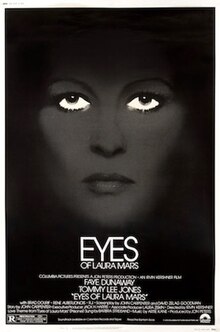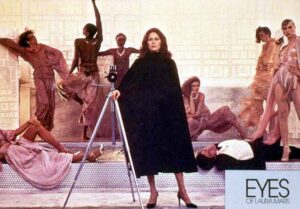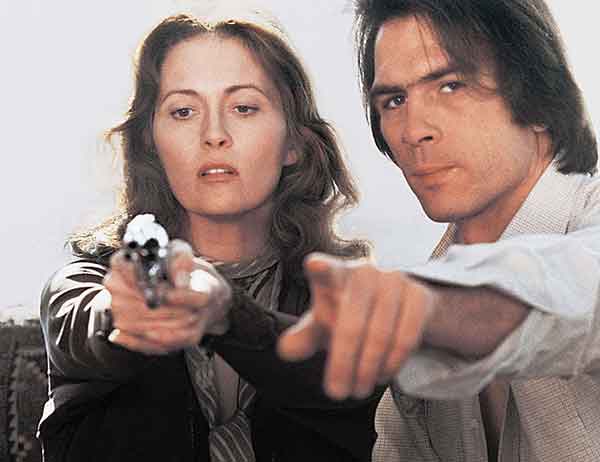 One of the foremost examples of American made giallo, with links to classics of the form like FOUR FLIES ON GREY VELVET/4 mosche di velluto grigio (1971) and EYEBALL/Gatti rossi in un labirinto di vetro (1975), and a foreshadowing of BLINK (1993). EYES OF LAURA MARS (1978) was executive produced by THE BLOB’S late Jack H. Harris (1918-2017) and overseen by John Peters, who intended it as a starring vehicle for his then-girlfriend Barbara Streisand. Obviously Streisand’s casting never occurred, although Peters did get her to record a song for the soundtrack.
One of the foremost examples of American made giallo, with links to classics of the form like FOUR FLIES ON GREY VELVET/4 mosche di velluto grigio (1971) and EYEBALL/Gatti rossi in un labirinto di vetro (1975), and a foreshadowing of BLINK (1993). EYES OF LAURA MARS (1978) was executive produced by THE BLOB’S late Jack H. Harris (1918-2017) and overseen by John Peters, who intended it as a starring vehicle for his then-girlfriend Barbara Streisand. Obviously Streisand’s casting never occurred, although Peters did get her to record a song for the soundtrack.
The project began with a spec script by John Carpenter called EYES that, it seems, nobody much liked. The acclaimed British filmmaker Lindsay Anderson, who was approached to direct, turned down the assignment because he found the screenplay “awful,” while the eventual director Irvin Kershner (19923-2010) bragged that he “threw out” Carpenter’s work—which was, to be exact, substantially rewritten by David Zelag Goodman (STRAW DOGS) and an uncredited Julien Barry.
Laura Mars (Faye Dunaway, coming off her Oscar-winning turn in NETWORK) is a world famous fashion photographer notorious for her violent and sexual imagery (inspired by the controversial 1970s photographer Chris Von Wangenheim, and created for the film by Helmut Newton). On the eve of a gallery opening she visualizes an unknown someone’s POV through which she, and we, see the person stabbing out an eye on the cover of Laura’s soon-to-be-published photo book. For reasons that are never revealed Laura periodically assumes the viewpoint of this unknown individual, which occurs more often than not when he’s killing someone. Furthermore, it seems this “talent” has directly inspired the disturbing imagery of Laura’s photographs.
The uber-glitzy gallery opening occurs, and is rocked by news of the murder of Laura’s editor—which Laura witnesses through the killer’s eyes. More of her colleagues are killed, and visualized by Laura, who seeks the help of Neville (Tommy Lee Jones), a gruff Lieutenant. These two initiate a sappy romance while attempting to find the killer, who might be Laura’s creepy chauffeur (Brad Dourif), her unpredictable ex-husband (Raul Julia) or her flamboyant agent (Rene Auberjonois). The culprit is eventually revealed in a climactic confrontation in which Laura, in the film’s most audacious scene, views herself through the killer’s eyes.
Say what you will about “Kersh,” but the man knew what he was doing. As with THE FLIM-FLAM MAN (1967), LOVING (1970), RAID ON ETEBBE (1976) and THE EMPIRE STRIKES BACK (1979) Kersh turned in an unerringly sleek, professional and stylish work. The zoom-ins on Dunaway’s eyes, frequent reflective imagery (with numerous scenes performed in front of windows and mirrors) and killer POV shots are among Kersh’s stylistic feats, coupled with a suitably gritty portrayal of New York City and a depiction of the fashion world that never feels less than fully authentic.
Faye Dunaway is at her most appealing in the title role, exuding old Hollywood glamour and a very up-to-date sexiness (Dunaway is known to like exposing her legs onscreen, and those gams are quite generously displayed here). Even better, she captures the haughty aloofness that tends to define upscale glamour queens like Anna Wintour and Donatella Versace. Tommy Lee Jones is also quite strong, although he can’t overcome the script’s deficiencies, which include (SPOILER ALERT!) a wholly ridiculous ending that sees the killer turn schizophrenic and deliver a beyond-hokey explanation for his crimes.
There’s also the issue of orientation, with the narrative wavering between the giallo influence of Carpenter’s conception and John Peters bequeathed slickness. The problem is that the material clearly wants to lean into the former extreme but was forced toward the latter, leaving us with a finished film as schizophrenic as its villain.
Vital Statistics
EYES OF LAURA MARS
Columbia Pictures
Director: Irvin Kershner
Producer: Jon Peters
Screenplay: John Carpenter, David Zelag Goodman
Cinematography: Victor J. Kemper
Editing: Michael Kahn
Cast: Faye Dunaway, Tommy Lee Jones, Brad Dourif, Rene Auberjonois, “R.J.” (Raul Julia), Frank Adonis, Lisa Taylor, Darlanne Fluegel, Rose Gregorio, Bill Boggs, Steve Marachuk, Meg Mundy, Marilyn Meyers, Gary Bayer, Mitchell Edmonds, Michael Tucker, Jeff Niki, Toshi Matsuo, John E. Allen


